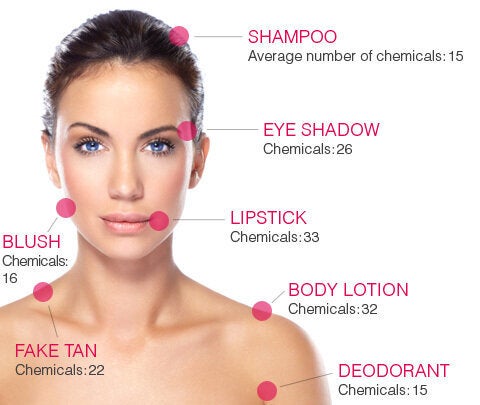If like myself, you are a self-proclaimed cosmetics addict, you too may find yourself running to the nearest corner in fear with what you are about to read. Since the young age of 12, I have been smearing my face in make-up with not even the slightest thought of what could be lingering within each product. It is safe to say that I put all of my trust in cosmetic companies to ensure that the products I purchase and use on a day-to-day basis are 100% safe.
As a blogger, I like to make it my mission to delve deeper and do my research when reviewing products. Since doing so, I have fallen into an unfathomable pit of deceit.
Studies show that a high quantity of our beauty favourites contain destructive toxins, many of which can cause lasting effects to the human body when exposed over long periods of time. These effects include respiratory damage and cancer. Inexcusably, before conducting my own research, these facts had never been brought to my attention. So here I am assuming that this is the same case for you too.
The beauty industry, in the UK alone, is worth around 17 billion pounds and from looking at these figures, I can see why brands are not putting more emphasis on the importance of monitoring the products we use. However, I do believe that makeup items containing toxic ingredients should come with a slight warning. This would help consumers monitor and limit the use of certain products but of course, this is not going to happen.
The majority of large beauty brands include an array of toxic ingredients, leaving it down to the consumer to research each one which is a highly tedious job and will most likely deter people from doing so.
Companies claim that these toxic ingredients are included in products at safe quantities but what if we use them day-to-day, will the effects soon take a hold? Terrifyingly my findings show that the most common toxic-infused beauty culprits include; creams (foundations and moisturisers), powders, eyeliners, mascaras and lip products. Basically the most commonly used makeup and beauty items!

Toxic components to look out for
Benzophenone
Commonly found in: Lip Products
Use: Ultra Violet rays alter the scent and colour of cosmetics. Benzophenone prevents this.
Dangers: Substantial exposure to Benzophenone can cause irritation to the skin and vapours promote reactions such as sneezing and shortness of breath.
Carbon Black
Commonly found in: Eyeliner, mascara and Lipstick
Use:Carbon Black is added to products requiring its dark pigment.
Dangers: Long term exposure to Carbon Black has been linked to Cancer and if inhaled can have detrimental effects on the respiratory system.
Titanium Dioxide
Commonly found in: Pressed power, loose powder and sunscreen
Use:Titanium dioxide is resistant to discolouration and reflects UV light.
Dangers: Titanium Dioxide, in the form of nanoparticles, is able to penetrate the skin and enter the bloodstream. This can have toxic effects on the brain, causing nerve damage and can also contribute towards cancer.
Butylene Glycol
Commonly found in: Foundation, sunscreen and moisturiser
Use: Butylene Glycol, when added to cosmetics, acts as a preservative.
Dangers:Butylene Glycol is a very powerful chemical which has the strength to clean industrial surfaces. As it is very potent, it is able to penetrate the skin, weakening protein and cellular structures. Over-exposure to Butylene Glycol can cause brain, kidney and liver abnormalities.
The Big 7 cosmetic companies should try harder
According to SafeCosmetics.org, the toxins mentioned above, are commonly used within the Big 7's cosmetics; Avon, Estee Lauder, Johnson & Johnson, L'Oréal, P&G, Revlon and Unilever. Although it does seem that they have some areas covered, cancer inducing ingredients are still being added to our cosmetics.
Benzophenone does not seem to be regulated across any of these brands. Carbon Black is monitored by P&G and Johnson & Johnson only. Heavy metals are regulated by all but P&G, Revlon and Unilever. Lastly, Butylene Glycol has only some transitional polices across Avon, Johnson & Johnson, L'Oréal and Revlon... This is not good enough.
I have spent the majority of my life being naive. To think that brands would never include harmful ingredients and if so, would give us a warning. It is not in their current interest to eliminate these ingredients. Therefore, it is down to us to do our research. There have been many cases of innocent people getting sick from long term use of household beauty products. This needs to stop. Incredibly true organic brands are out there. They work hard to put an end to unnecessary toxic chemical usage so why are we not investing our money into these instead? Although, agreed they may be on the pricier side, is it not worth it, for the sake of your own health?